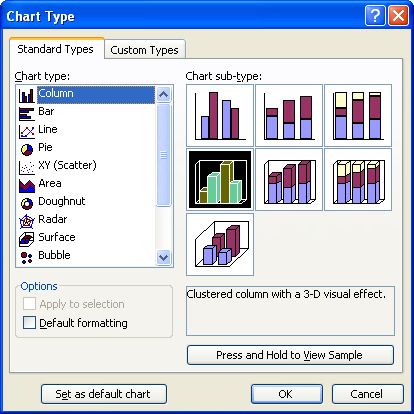Please Note: This article is written for users of the following Microsoft Excel versions: 97, 2000, 2002, and 2003. If you are using a later version (Excel 2007 or later), this tip may not work for you. For a version of this tip written specifically for later versions of Excel, click here: Changing Chart Types.
Written by Allen Wyatt (last updated February 26, 2022)
This tip applies to Excel 97, 2000, 2002, and 2003
Excel makes changing chart types of an existing chart a breeze. You can change chart types by following these steps:

Figure 1. The Chart Type dialog box.
ExcelTips is your source for cost-effective Microsoft Excel training. This tip (3210) applies to Microsoft Excel 97, 2000, 2002, and 2003. You can find a version of this tip for the ribbon interface of Excel (Excel 2007 and later) here: Changing Chart Types.

Professional Development Guidance! Four world-class developers offer start-to-finish guidance for building powerful, robust, and secure applications with Excel. The authors show how to consistently make the right design decisions and make the most of Excel's powerful features. Check out Professional Excel Development today!
When working with charts and chart objects, Excel is very dependent on the mouse. If you don't want to use the mouse, but ...
Discover MoreWant to adjust the perspective from which your 3-D graph is viewed? Excel allows you to use the mouse to rotate the graph ...
Discover MoreWhen adding AutoShapes to a worksheet, it can be bothersome to continually work with the menu structure to place them. It ...
Discover MoreFREE SERVICE: Get tips like this every week in ExcelTips, a free productivity newsletter. Enter your address and click "Subscribe."
There are currently no comments for this tip. (Be the first to leave your comment—just use the simple form above!)
Got a version of Excel that uses the menu interface (Excel 97, Excel 2000, Excel 2002, or Excel 2003)? This site is for you! If you use a later version of Excel, visit our ExcelTips site focusing on the ribbon interface.
FREE SERVICE: Get tips like this every week in ExcelTips, a free productivity newsletter. Enter your address and click "Subscribe."
Copyright © 2025 Sharon Parq Associates, Inc.
Comments